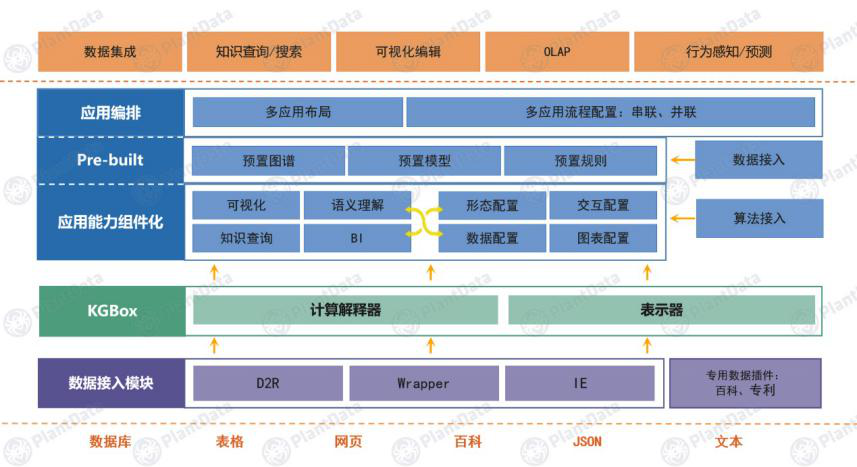The knowledge graph construction and application platform has been upgraded to a cognitive intelligent middle platform, which has already landed in the industry’s major customers.
Artificial intelligence has made relatively great breakthroughs in the areas of perception such as “listening, speaking, and seeing”, but it is still at a very early stage in the field of cognitive intelligence in logical reasoning and knowledge transfer. Knowledge graphs, as the underlying technology to realize the cognitive intelligence of robots, can help machines better understand data and perform high-precision knowledge extraction, and use knowledge mining, reasoning, and visual analysis to better explain phenomena and assist human decision-making. analysis.
The application of knowledge map can be divided into two major directions. One is the general knowledge map, represented by Google, Baidu, Bing, Sogou; the other is the industry knowledge map, such as Palantir, which has been valued at over 20 billion U.S. dollars as early as 2015, and faces the field of defense public security, and American company MAANA for the energy sector. In the process of landing artificial intelligence, it is necessary to have the knowledge of the entire business process Know-How, and the knowledge map plays a key role.
In the process of constructing the knowledge map, the platform can be used to solve the problems of difficult integration of heterogeneous data from multiple sources, dynamic changes in data models, difficulty in mining unstructured data, and difficulty in unifying data consumption. This reduces the industry knowledge map. Landing threshold. However, in terms of project landing, there are still problems such as long map construction cycles, high professional construction levels, and high cross-industry migration costs. The challenges brought about by this will be reflected in whether the product can be used out of the box, whether there are relevant industry schemas to learn from, how to solve the high cost of multi-source heterogeneous data combing, and whether users can build applications on their own.
In order to solve the above problems, PlantData proposed to upgrade the knowledge graph construction and application platform to a cognitive intelligence middle stage.
PlantData was established in 2017, and its current business focuses on the military and financial sectors. PlantData combines product components with the needs of users’ business scenarios to facilitate users to quickly convert data into the knowledge map through dozens of adapters to achieve knowledge modeling, knowledge acquisition, knowledge fusion, knowledge storage, knowledge calculation, knowledge Knowledge Graph Full Life Cycle Solutions .
In terms of reducing the cost of enterprise big data to knowledge conversion, PlantData has formed a out-of-the-box architecture by means of component microservices, pre-construction of models & data models, and business orchestration, and Help users improve database grooming efficiency, while supporting self-service building applications , and improve the efficiency of enterprise digital transformation.
In addition, in the storage of knowledge graphs, PlantData does not use graph databases commonly used in the industry.Instead, I developed a hybrid storage engine to strengthen the analysis performance of the system, and it has better scalability than graph databases. The engine supports efficient storage of various types of data such as graphics, documents, records, etc. It also has the characteristics of data semantic consumption and graph structure consumption.

Central Intelligence Based on Knowledge Graph
PlantData has formed a product system around the cognitive graph cognitive intelligence middle stage, including: Knowledge Graph Full Lifecycle Management Platform (KGMS), Intelligent Question Answering Robot (KGBot), Knowledge Graph Automated Construction Platform (KGBuilder), Enterprise-level Intelligent Assistant (KGAssist), intelligent text extraction platform (KGText), and lightweight construction product (KGLite). At present, it has accumulated about 40 industry benchmark users, mainly large state-owned enterprises and state-owned enterprises, with a unit price of millions of customers, including China Electric Power, AVIC, China Shipbuilding Industry, AVIC Lianchuang, State Grid, CITIC Construction Investment, Bank of China , Huawei, Xinhua News Agency, etc. It has also established channel cooperation relationships with iSoftStone Power, Guodian NARI, and Lanling.
PlantData founder Ding Jun told that customers can basically be divided into three categories: the first category is customers who have certain development capabilities, and the second category is customers or integrators with pure product procurement requirements; the third category Customers who need to provide customized end-to-end services. The first two types of customers are the main source of customers, and the company mainly sells standardized products.
PlantData team is about 60 people, mainly R & D personnel. It is understood that its core team has more than ten years of R & D experience in the field of semantic web and knowledge graphs. The company proposed a method for full life cycle management of knowledge graphs at the 2017 CCKS (National Knowledge Graph and Semantic Computing Conference). PlantData revealed that revenue in 2019 has reached tens of millions, and it is expected to grow at a rate of three times in 2020. PlantData won a 10 million yuan angel round invested by Songhe Capital in December 2017, and completed a balance of 15 million yuan in Pre A rounds of Dynamic Balance Capital and AVIC Lianchuang in June 2019. 10,000 yuan A1 round of financing.